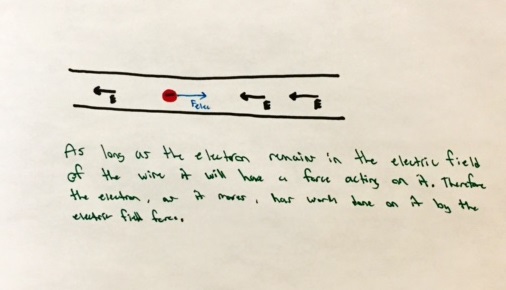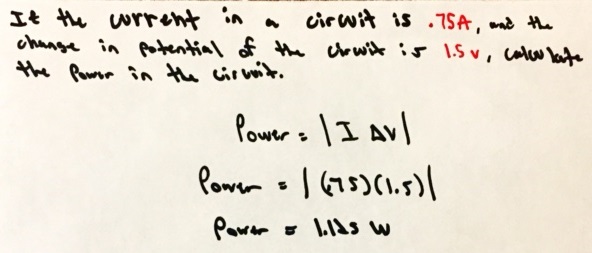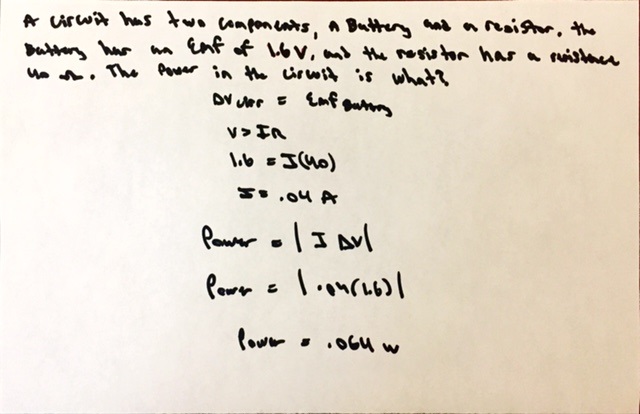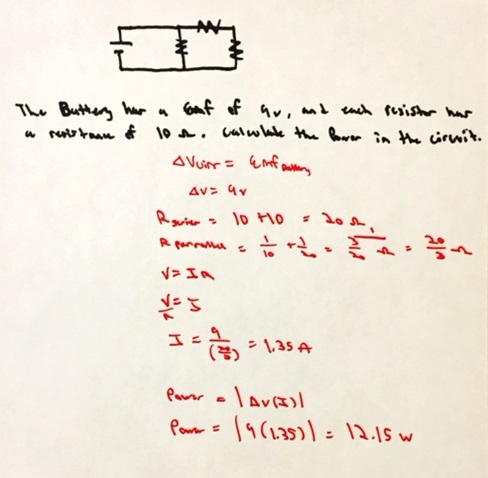Work and Power In A Circuit
Inside wires, there are flowing charges, electrons or positive “holes”, which are known as current. Due to the fact these charges are moving through the wires, it can be inferred that there is some kind of force acting on them and doing work as the particle traverses the wire. This work and subsequently power can be calculated.
The Main Idea
Mechanical work is the product of force and displacement. Electrical work can be related to this by considering a particle with charge “q” in a region or electrical field “E”. The force acting on that particle would be F = q*E. As the force begins to act on the particle, the particle will begin to move. As the particle moves the work on that product is the integral of E dot multiplied with the displacement of the charged particle. Alternatively, the Force can be calculated by determining the potential difference and multiplying by the charge “q”. Inside a wire, the same principals apply. The Pockets or charge, whether they are positive “holes” or electrons, that are moving through wires because of a force generated by an electric field.
A Mathematical Model
As the charged particles in the wire move, the electric potential of that particle decreases. This change in electric potential (dV) can be used to calculate the change in electric potential energy (dU).
dU = (dq)(dV)
-Work = dU
Power is equal to the work done over the change in time.
Power = | dU/ dt | = | (dq*dV)/dt |
However, current “I” is equal to dq/dt so…
Power = | I(dV) |
A Computational Model
Examples
Be sure to show all steps in your solution and include diagrams whenever possible
Simple
Middling
Difficult
Connectedness
As a future Mechanical Engineer, I will likely make a career for myself building or designing machines. A Fundamental understanding of how the circuitry providing electricity to the machines I will be making will be essential. Understanding what exactly is going on inside a circuit will allow me to factor in the limitations of the circuitry when designing machines. Therefore, allowing my designs to more closely abide by the Resilient Modeling Strategy rules of manufacturing and design by “designing with intent.” Making my designs more viable and me a better engineer.
History
In 1750, Benjamin Franklin proposed an experiment to prove lightening is electricity. This would later become colloquially known as Franklin's Key on A Kite experiment. Then on May 10, 1752, Thomas-François Dalibard performed the experiment with a 40 ft iron pole, and managed to extract charge from clouds in a thunderstorm. As people analyzed the results of these experiments and continued to perform similar ones, the idea of electricity was founded.
See also
Further reading
Power: Putting Charges to Work [1]
External links
[Wikipedia Work (electric): [2]]
[Wikipedia Benjamin Franklin: [3]]
References
Chabay, Ruth W., and Bruce A. Sherwood. Matter and Interactions. 3rd ed. Vol. 2. N.p.: John Wiley and Sons, 2002. Print.



